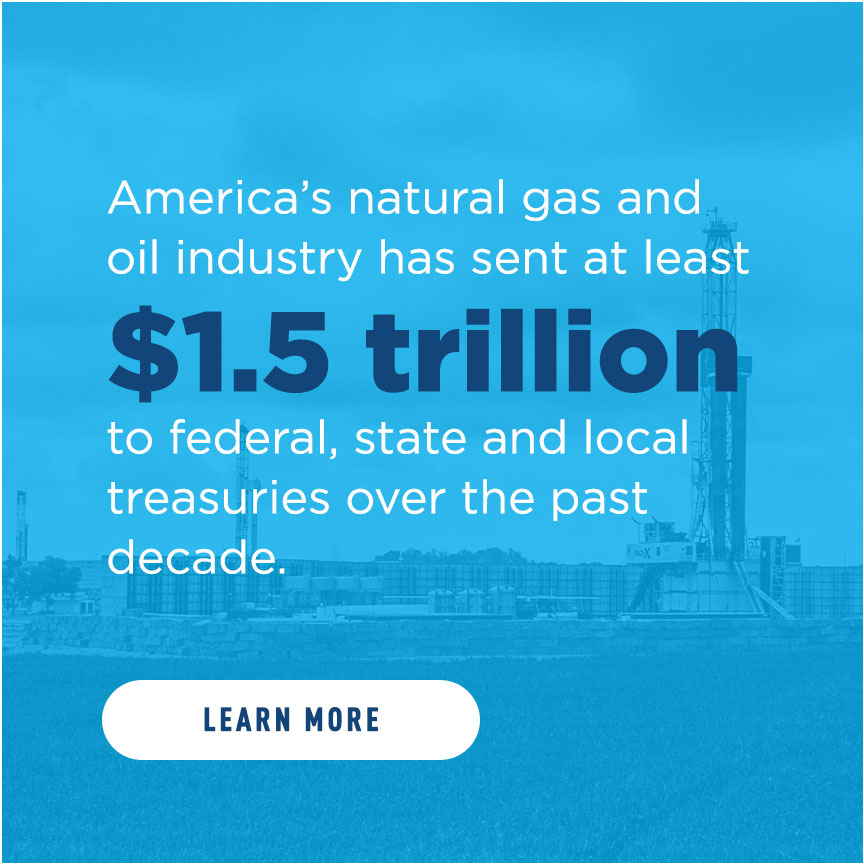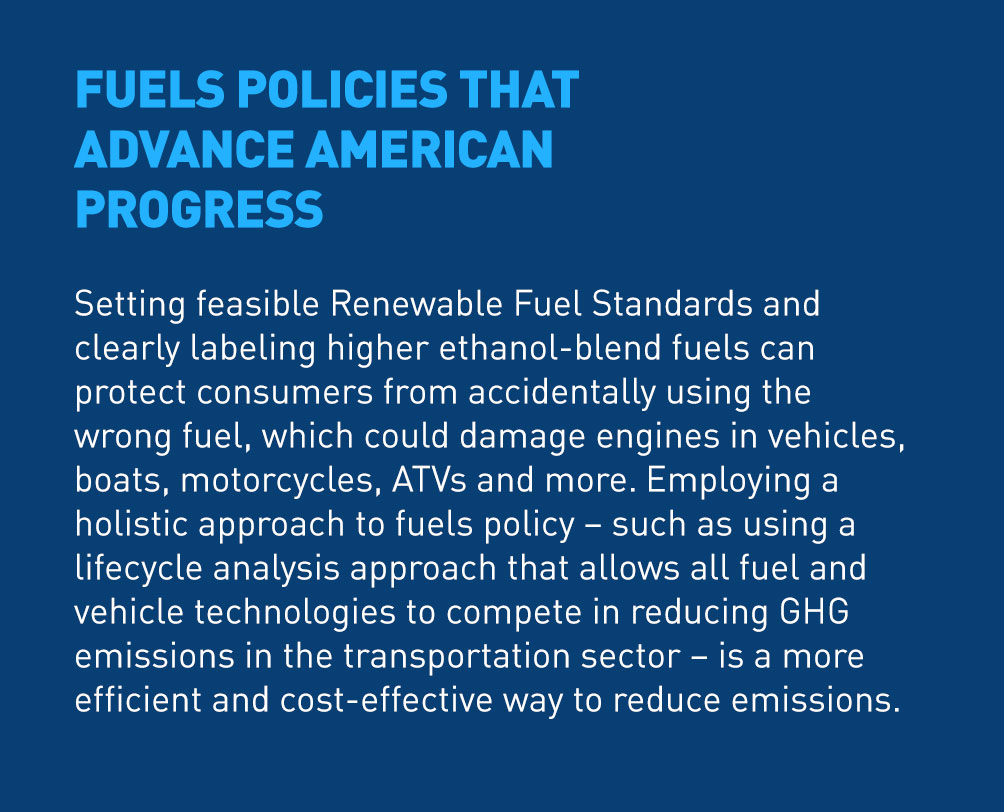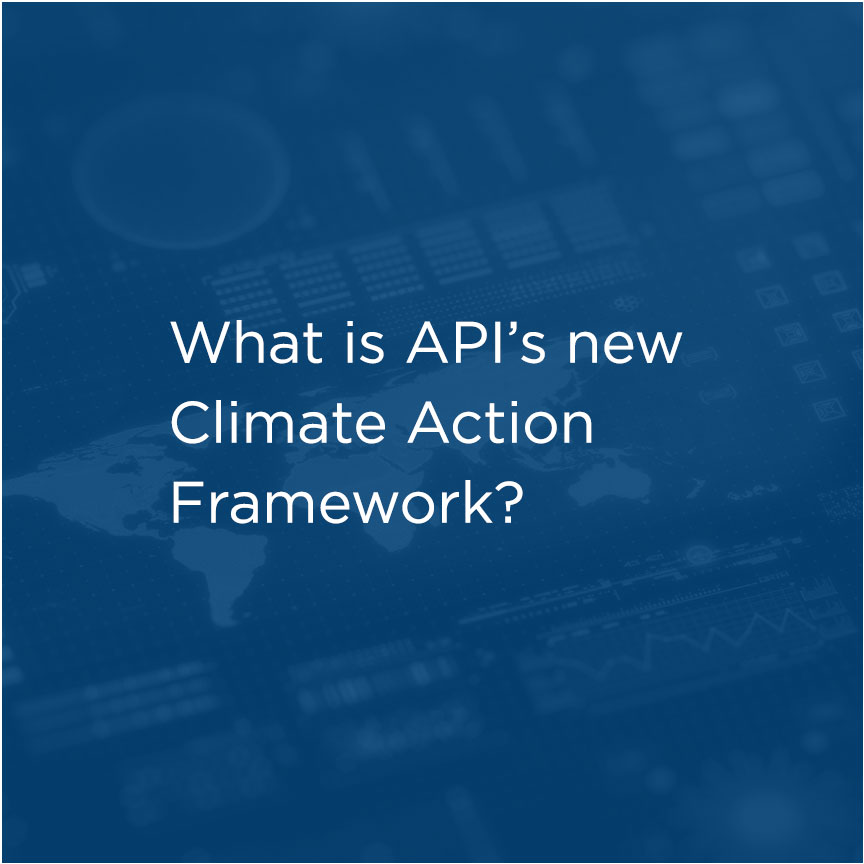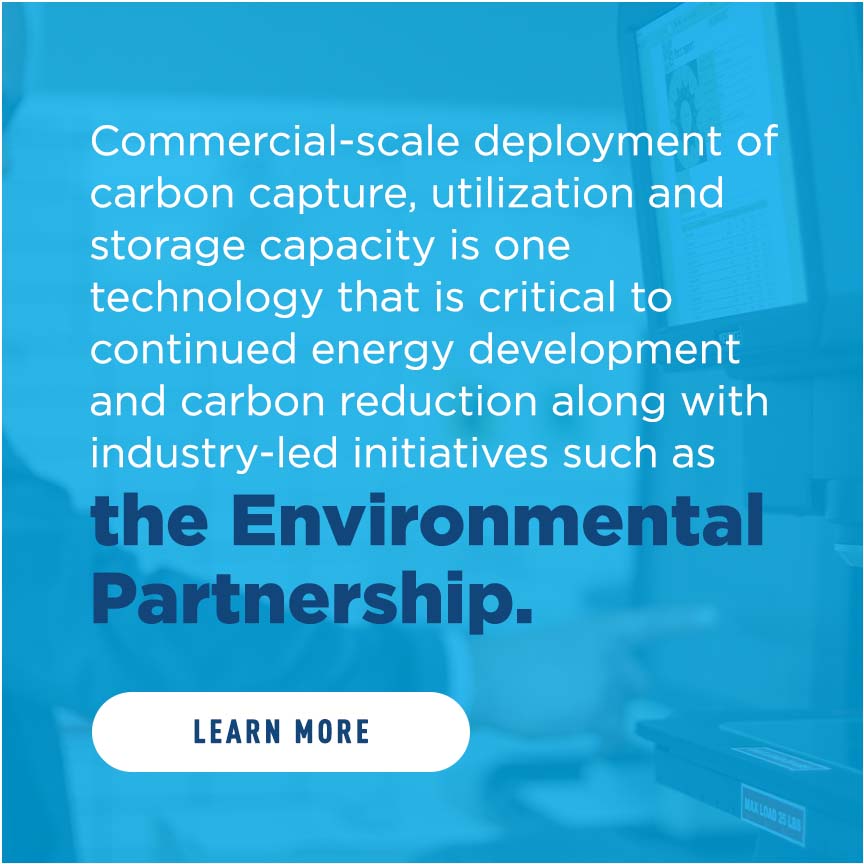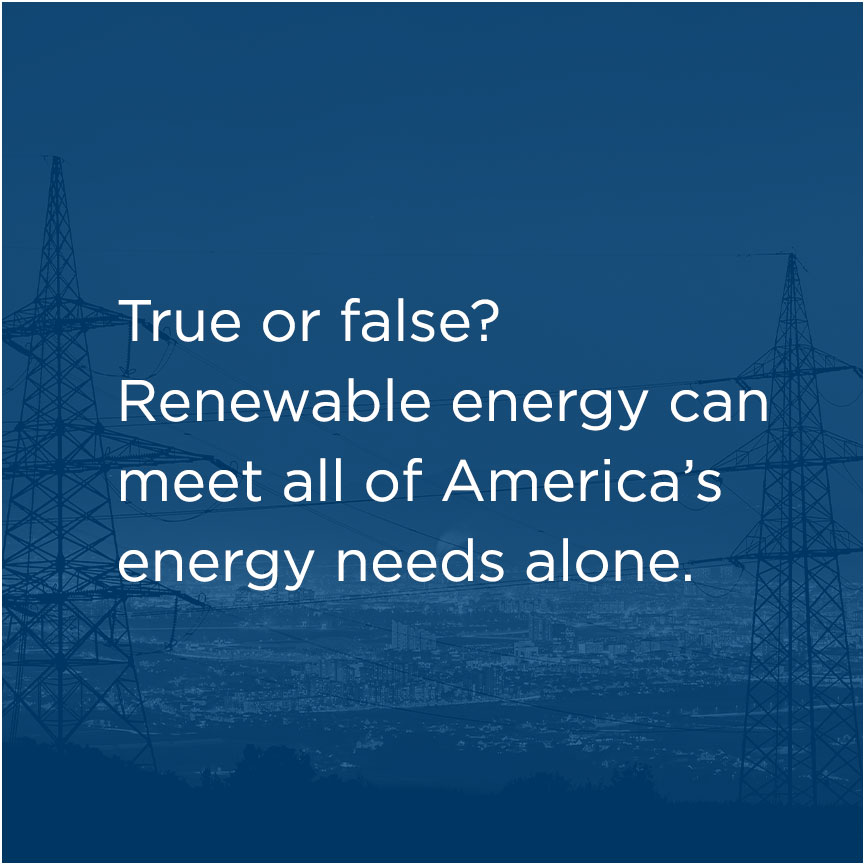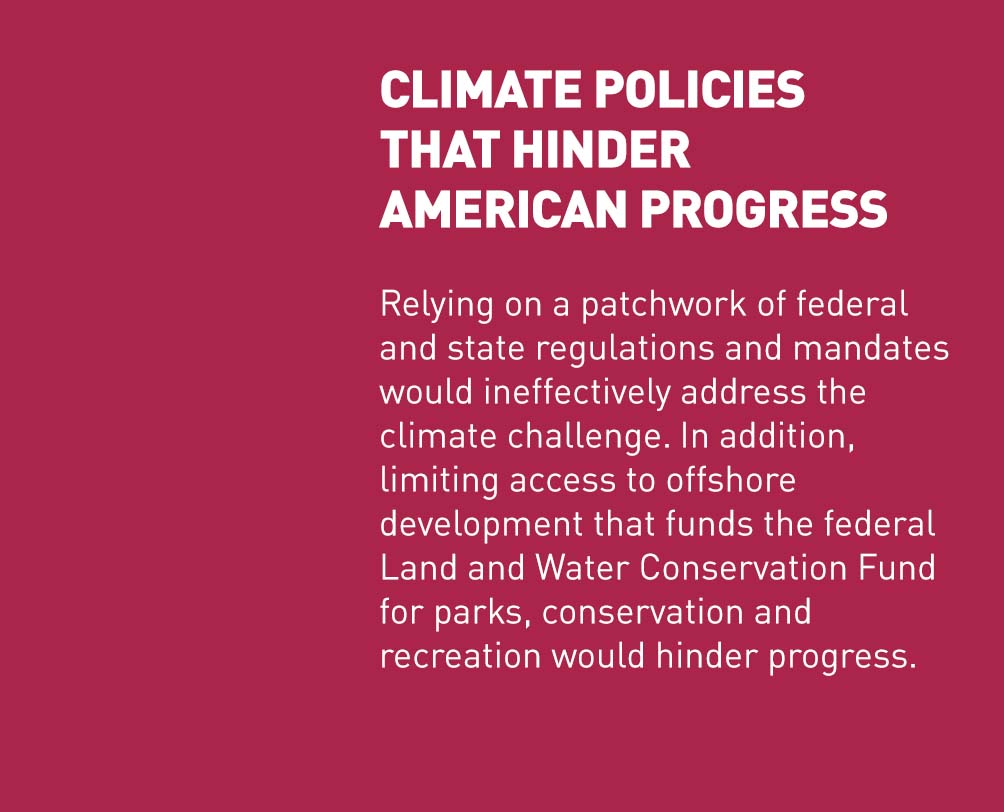
Progress. It’s made in America and powered by natural gas and oil. Energy is foundational to our success as a nation – from excellence in manufacturing, defense, and aerospace to advancements in technology to unlock innovation and better protect our environment. In everything they do, Americans are empowered by affordable and reliable energy from natural gas and oil produced right here at home. In the report that follows, we’ll look at the ways these leading domestic energy sources are driving progress – in our communities, across the nation and around the world – creating opportunity for better lives and keeping America strong while reducing emissions and minimizing the footprint of energy production.

Progress is possible because of energy. It’s in everything Americans use, make, wear, drive and more. Access to the energy we use every day is foundational to our freedom. Without energy, we’re dependent on others to supply it. Domestic natural gas and oil is made, moved, and used in communities where we all live and work.
Industry-Supported Jobs Strengthen Local Economies
The industry supports 11.3 million jobs nationally, but in reality the true employment benefits of natural gas and oil companies extend to all corners of the country – in America’s cities and towns in all 50 states and the District of Columbia. The benefits are felt in every segment of the industry’s direct, indirect and induced jobs, labor income and value added, which is a measure of industry’s portion of GDP.
For example, natural gas and oil industry jobs in New Mexico’s 2nd Congressional District account for more than 17 percent of the state’s total jobs, 21 percent of its labor income and 32 percent of its value-added (GDP).
Meanwhile, U.S. natural gas and oil companies have sent more than $1.1 trillion to federal, state and local treasuries through taxes, royalty payments and fees over the past decade, according to API estimates. State treasuries have received more than $20 billion in the past two years from severance taxes, the vast majority paid by the industry to fund local and state public projects, including schools, public safety programs and facilities, roads, sanitation and more.
Click on the image to learn more
Plentiful American Energy Helps Family Budgets
Abundant domestic energy has helped reduce energy costs for American households over the past decade. U.S. household expenditures for energy decreased 25 percent between 2008 and 2020, while expenditures for food, education and healthcare have increased, ranging from 22 percent to 74 percent, according to the U.S. Bureau of Labor Statistics.
In recent months, global demand for energy has outstripped supply as pandemic quarantines ease. This has put upward pressure on energy costs for families and businesses. These costs are higher in regions of the U.S. where Americans depend on foreign energy imports and where U.S. pipeline and other infrastructure is scarce. API has called on U.S. policymakers to remove barriers to development of American energy and infrastructure necessary to deliver energy where it is needed most.

Jacqui Schlachter
District Operations Manager
She has a passion for her community, volunteering for the Leukemia & Lymphoma Society’s Woman of the Year campaign. Giving back, she says, is part of progress.
U.S. Petroleum Products Improve Domestic Life
If American progress can be defined by the products that make everyday life better, natural gas and oil fit the bill.
At U.S. refineries, crude oil and natural gas liquids become fuels and feedstocks used primarily to manufacture chemicals, synthetic rubber and a range of plastics found in a variety of items that Americans use every day.
These include soaps and detergents, cell phones, clothing, solvents, medicine, fertilizers, pesticides, synthetic fibers, paints, epoxy resins, flooring and insulating materials.
Did you know that petroleum is a key ingredient in:

Industry Invests in Local Workforces of the Future by Boosting STEM Education and Engaging Minority Serving Institutions
Occupations requiring skills and training in the science, technology, engineering and mathematics (STEM) disciplines – which are foundational for tens of thousands of well-paying natural gas and oil industry jobs – currently make up 20 percent of all U.S. jobs. The industry’s future workforce will be led by STEM-educated women and men, so it has a great interest in initiatives that advance education in these fields. API has partnered with Discovery Education to launch the STEM Careers Coalition, which is focused on bridging the workforce skills gap in U.S. K-12 schools. The goal is to improve learning for 10 million students in 5,000 schools nationwide through direct investments in classrooms, connecting industry employees and students, and creating an easily accessible career portal.
In addition, API’s Minority Serving Institutions Initiative provides its 700+ industry standards catalog to students at Historically Black Colleges and Universities and other minority-serving institutions, free of charge. These include Fort Valley State, Grambling State University, New Mexico State, Prairie View A&M University, San Jacinto College, Southern University, and the University of Hawaii. This access allows schools to introduce their students to practical knowledge and industry standards that will be immediately applicable in their future careers. The initiative is integral to the industry’s goals of an increasingly diverse workforce that will make the industry stronger, smarter, and better.

Offshore Oil and Natural Gas Investments Fund Local Conservation and Recreation Efforts in Every State
One of the nation’s most important conservation programs, the Land and Water Conservation Fund (LWCF), is paid for primarily by revenues from offshore oil and natural gas production. Since 1965, the LWCF has sent billions of dollars for conservation and preservation to local projects across the 50 states and District of Columbia.
Congress passed the bipartisan Great American Outdoors Act in 2020 to provide permanent, dedicated LWCF funding to help sustain local conservation efforts.
Cleaner Fuels Have Helped Reduce Vehicle Emissions
U.S. refiners continue to produce cleaner gasoline, diesel, and other fuels. This has been done over the years by removing sulfur and other elements during the refining process. Coupled with advanced vehicle technologies, cleaner fuels mean today’s new cars, SUVs and pickup trucks are about 99 percent cleaner for most tailpipe pollutants than vehicles in 1970. In addition, since 2004 new light-duty vehicle fuel economy has improved by 29 percent, and their related carbon dioxide (CO2) emissions have dropped 24 percent, according to EPA. Companies also are producing innovative feedstocks and polymers for products, such as improved lubricants and fuel-efficient tires, that contribute to reducing greenhouse gas (GHG) emissions from road transportation.
To further tackle transportation-related emissions, API supports federal fuels policy that drives near-term and ongoing CO2 emissions reductions.
Establishing a carbon intensity standard for the motor fuel pool that declines over time is one way to achieve these reductions. This would benefit not only new vehicles, but it also could achieve emissions reductions across the entire existing vehicle fleet. Evaluating vehicle GHG emissions on a well-to-wheels basis, rather than the current tailpipe-only approach, would allow the market to drive carbon emissions reductions at the lowest cost to consumers, while preserving vehicle choices.
Linking fuel and vehicle standards could ensure consistent CO2 reductions across technology options and provide incentives to reduce GHG emissions to the broad spectrum of industries that power the transportation system, including automakers, engine and equipment makers, petroleum refiners, power generators, and biofuels manufacturers.
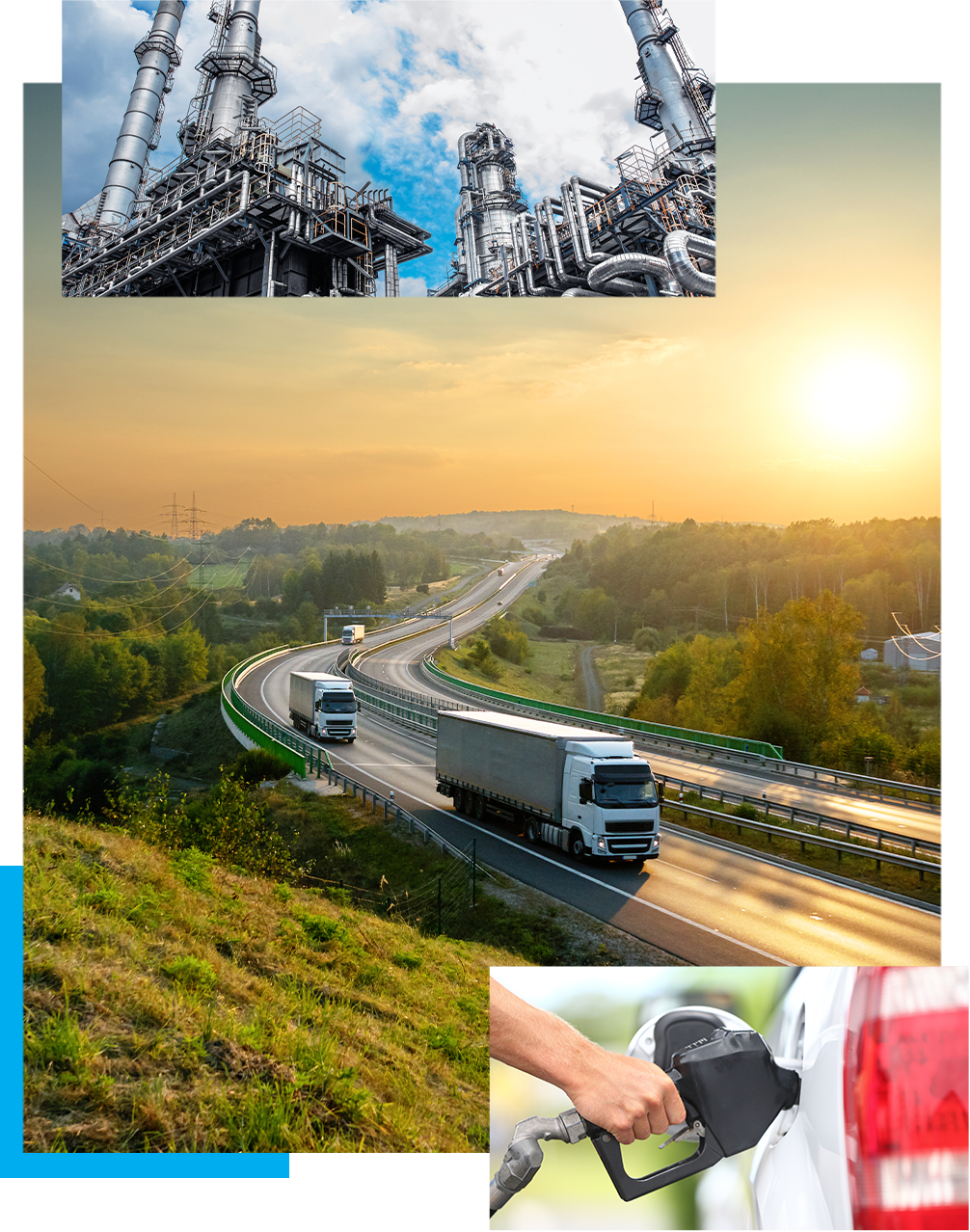
Natural Gas Enables Local Growth of Wind and Solar Power
Growing global energy demands for affordable, reliable and lower-carbon energy require the contributions of all energy sources, and that those sources work together. Natural gas is the essential backstop and partner for growth of intermittent renewable energy from wind and solar.
Natural gas has unique attributes – dispatchability, rapid ramp-up capability, reliability and more – that enable it to fuel power generation, especially when wind and solar aren’t available, and strengthen grid health. Natural gas and oil are also used in manufacturing solar panels and wind turbine blades.
Meanwhile, increased use of natural gas in generating electricity is the primary reason why U.S. CO2 emissions have fallen to generational lows. Fuel switching from coal to natural gas has accounted for more than 60 percent of reduced CO2 emissions from the power sector since 2005.
Natural Gas, Renewables and CO2 Savings in Electricity Generation
Zach Conrad
Completions Engineer
A Pennsylvania native, Zach has witnessed the incredible growth of the natural gas industry. He started out swinging hammers as an industry laborer and is now an engineer dedicated to producing reliable energy while evaluating new technologies. Zach is a local elected official and enjoys sharing the progress our industry has achieved.
Policies that Affect Communities
Federal fuels and transportation policies should allow all vehicles and fuel technologies to freely compete on a level playing field to reduce transportation-sector emissions – protecting consumers, their vehicles and wallets, and preserving customer choice without using mandates and bans that distort the market. Policymakers could improve the Renewable Fuel Standard by moving away from ever-increasing volumetric mandates and refocusing the standard to maximize opportunities to produce and blend lower-carbon biofuels. Zero emission vehicle (ZEV) mandates that ban new gasoline- and diesel-fueled vehicles limit options for Americans who can’t afford a ZEV or might prefer a conventionally powered vehicle. Further, such mandates eliminate the opportunity to reduce GHG emissions through high-efficiency vehicles powered by lower carbon-intensity fuels. A ZEV mandate for medium- and heavy-duty trucks and vans could postpone air quality improvements by decades and forgo opportunities for other technologies to deliver earlier and more cost-effective solutions.
A technologically advanced U.S. infrastructure system – including pipelines, waterways, rail and trucking networks – safely connects American consumers with abundant U.S. energy found in natural gas and oil. Fully harnessing American energy, including bringing the benefits of natural gas and oil to all parts of the country, depends on modern infrastructure – expanding current capacity and building new capacity. Acknowledging the broad public good stemming from reliable energy infrastructure is critically important to permitting and building needed projects. Moving forward, project reviews that follow transparent and set timelines are needed to clearly and consistently establish requirements for operators. Specifically, the Nationwide Permit 12 program should be renewed; the National Environmental Policy Act (NEPA) should be amended to provide greater regulatory certainty and help improve the NEPA process; and the Federal Energy Regulatory Commission (FERC) should conduct ongoing, apolitical reviews of pipeline and liquefied natural gas export projects. API will continue to promote timely and consistent permitting, appropriate regulatory jurisdiction for interstate pipelines, cost-effective regulations, and continued access for infrastructure development and maintenance.
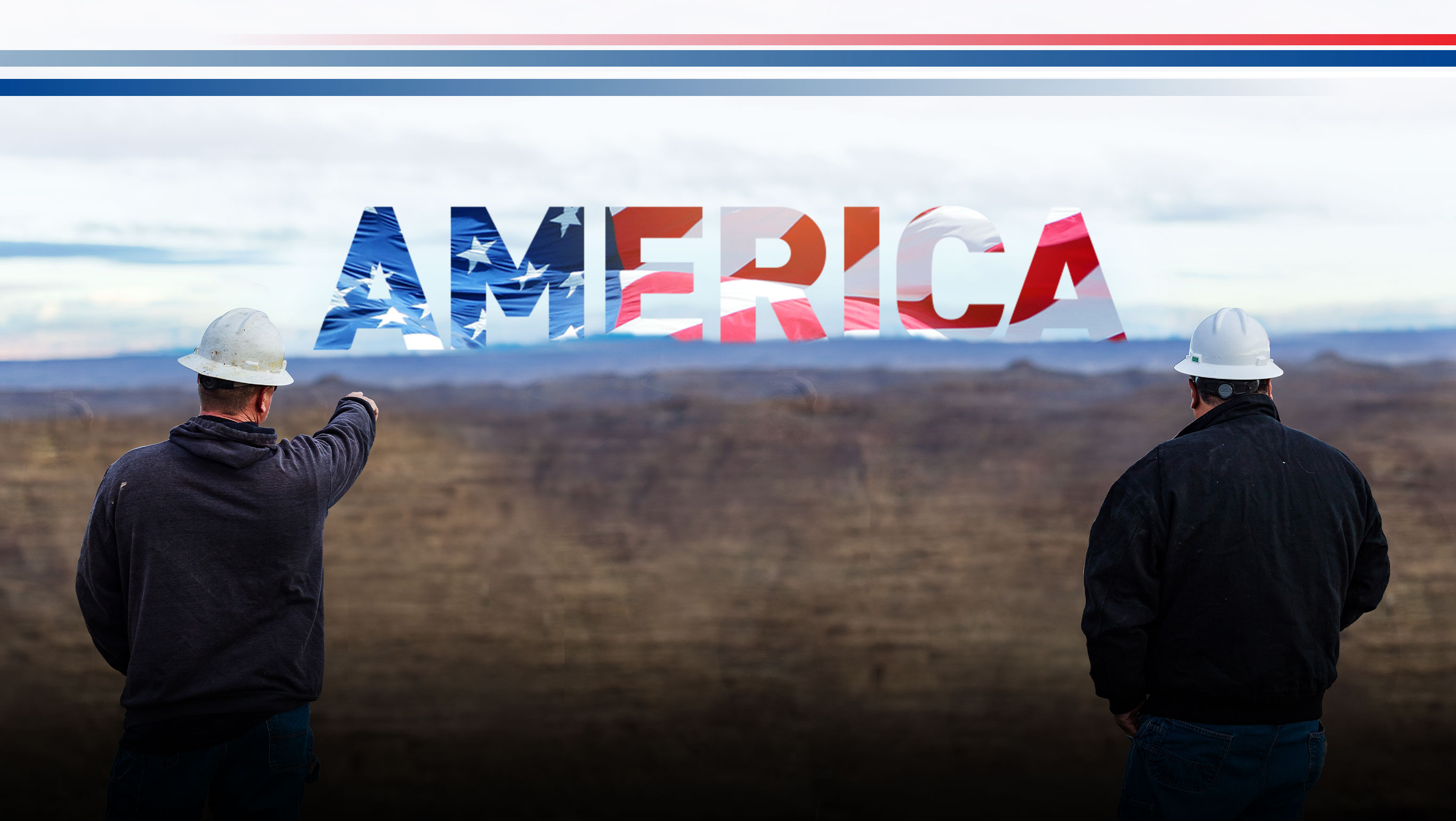
Natural gas and oil drive American progress. Whether the issue is jobs, economic growth, increased energy security or a better environment, all of these require the energy provided by U.S. natural gas and oil. Together, natural gas and oil supplied nearly 70 percent of America’s energy in 2020, and the U.S. Energy Information Administration projects them to account for about 70 percent of energy needs in 2050. Access to affordable, reliable energy from natural gas and oil makes modern life possible today, and they will play a leading role in driving American progress decades from now.
U.S. Natural Gas and Oil Production, Adhering to Among the Highest Safety and Environmental Standards, Leads the World
The U.S. is the global leader in natural gas and oil production, which is essential to the U.S. and other modern economies. U.S. leadership was achieved through development and deployment of safe and innovative technologies, including advanced hydraulic fracturing, 4D imaging and horizontal drilling, that accessed previously unreachable U.S. resources while increasing efficiency and reducing the environmental footprint of energy production.
U.S. Natural Gas and Oil Production
American Energy is Critical to National Security
Associated with energy leadership is energy security – ensuring that America continues to have access to affordable, reliable energy for the necessities of modern life. Americans saw the shale energy revolution rewrite our nation’s energy story.
From energy scarcity to energy abundance, this nation benefited from declining crude oil imports, greater self-sufficiency and strengthened security. For the first time in 67 years, the U.S. was a net energy exporter in 2019. This occurred just 46 years after the U.S. experienced a historic oil embargo by some foreign producers that left our nation vulnerable.
That’s progress – which can be extended anew by fully harnessing our American energy resources.
Using an Action-Oriented Blueprint,
Industry Provides National Climate Leadership
Using an Action-Oriented Blueprint, Industry Provides National Climate Leadership
The dual challenge of meeting global energy needs while also addressing climate change is a generational opportunity for American progress – bettering our nation and building a lower-carbon future.
The energy industry is taking action, harnessing its unique role to develop technology solutions and partnering to accelerate technology deployment.
While more work remains to be done, there has been notable progress: U.S. energy-related CO2 emissions are at generational lows, in significant part because of the increased use of natural gas to generate electricity. On the production side, average methane emissions intensity declined by nearly 60 percent from 2011 to 2020 across all seven major producing regions, according to data from EPA and EIA.
API’s new Climate Action Framework builds on this progress and provides a blueprint for accelerating industry and government actions to continue reducing emissions from energy production, transportation and use. It details a diverse range of policies, technologies and accountability measures that will foster meaningful emissions reductions.
Commercial-scale deployment of carbon capture, utilization and storage capacity (CCUS) is a critical technology for continued energy development and carbon reduction. Additionally, climate progress is being made through industry-led initiatives such as The Environmental Partnership, with its multi-faceted methane reduction programs, including flaring.
Falling Methane Rates in Natural Gas and Oil Production From Key Basins
Average methane emissions intensity – emissions relative to production – declined by nearly 60 percent across all seven major producing regions from 2011 to 2020
Click on the image to learn more
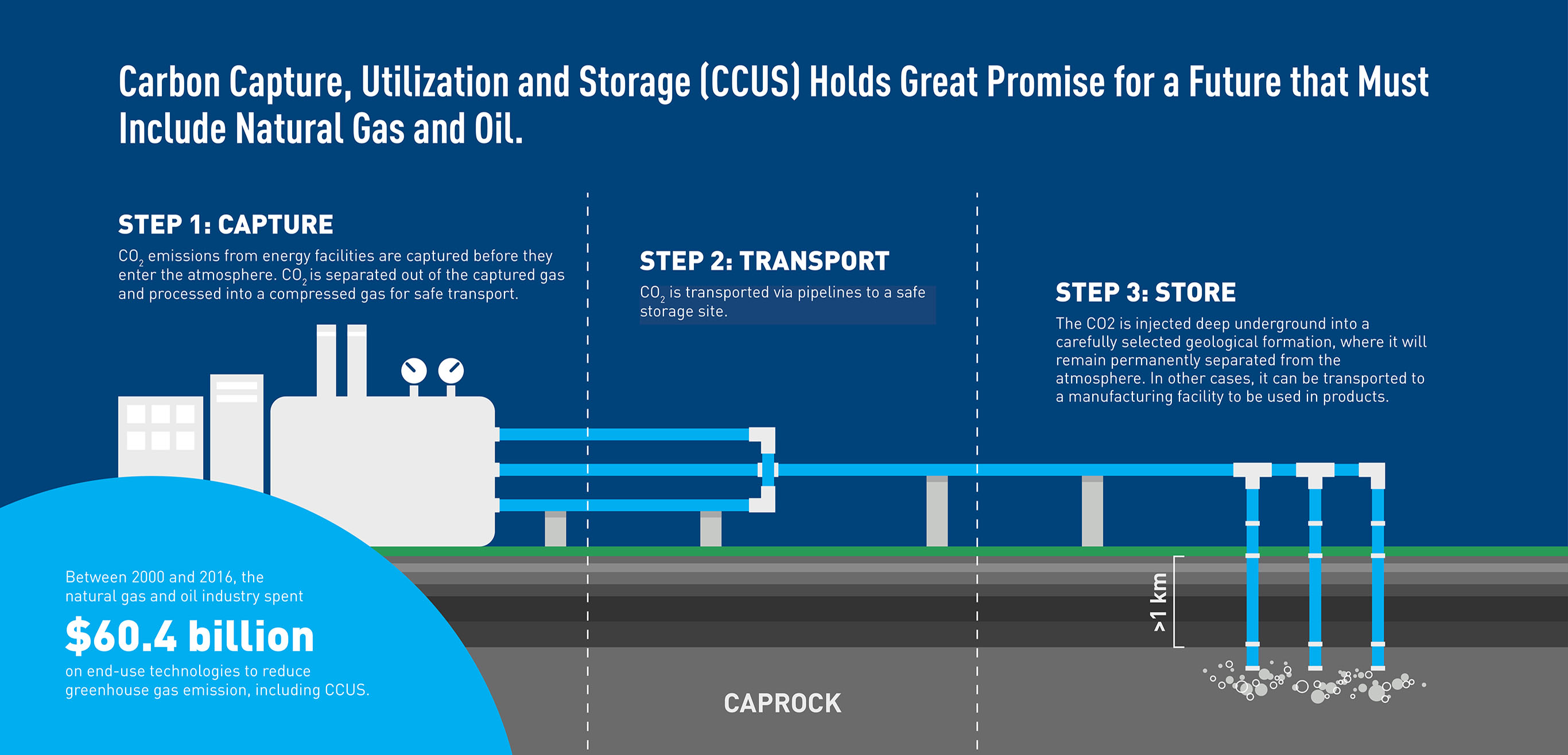
Industry-Supported Jobs, Wages and Benefits Fuel
National Economic Growth
Industry-Supported Jobs, Wages and Benefits Fuel National Economic Growth
Natural gas and oil supported 11.3 million American jobs in 2019, accounting for 5.6 percent of total U.S. employment. That means more than 1 in 20 jobs were supported by American energy. Nationally, every direct job in the natural gas and oil industry supported an additional 3.5 jobs elsewhere in the U.S. economy.
The industry’s impact on labor income – wages, salaries and benefits – totaled nearly $900 billion, while its contribution to U.S. GDP was nearly $1.7 trillion or 7.9 percent of the national total. In 31 states, the industry directly or indirectly supported at least 100,000 jobs in 2019. These numbers reflect widespread economic impact throughout all sectors of the U.S. economy.
Essi Kwabi
Petrophysicist
If you need to know the properties of a rock, its porosity or permeability, then you’ll need Essi on your team. Petrophysicists direct colleagues where to go to safely extract hydrocarbons. Passion is what drives Essi – from singing in her local church to finding the best ways to produce the energy America needs.
More American Women, Minorities Projected to Thrive in Oil and Gas
The natural gas and oil industry is committed to assembling a workforce that looks more like America. Nearly 50 percent of job opportunities in the industry through 2040 are projected to be filled by people who identify as women, African Americans, Hispanics, Asians or non-white. Their unique perspectives and contributions will strengthen our industry – even as API member companies foster diversity at every step in industry’s vast supply chain.
The industry’s projected workforce will grow to more than 2.3 million direct jobs by 2040. Retirements and other vacancies mean more than 1.9 million total new job opportunities through 2040.

Safe, Modern Infrastructure Serves America Every Day
Progress in America depends on getting the energy we have to the places where it’s needed. That’s where infrastructure comes in. Every day, a vast network serves Americans all across the country.
That includes more than 530,000 miles of transmission pipelines, the majority underground, safely delivering crude oil, petroleum products, natural gas, natural gas liquids and CO2/ethanol. Total crude oil and petroleum product barrels delivered by pipelines totaled nearly 22.8 billion barrels in 2019, an increase of more than 27 percent over the past five years.
Safety is our top priority, and our industry is focused on achieving zero incidents. Beyond pipelines, properly investing in coastal and inland waterway infrastructure ensures that the natural gas and oil industry – in addition to all other industries that rely on U.S. waterways – can continue to safely transport energy into, outside and around America.
API Energy Excellence Initiative Raises the Bar for Environmental, Safety and Sustainability Performance
API members are committed to continuously improving safety, environmental, security and sustainability performance throughout operations. The API Energy Excellence program includes 13 core elements – from corporate leadership and community engagement to emergency preparedness and risk management – that every API member is expected to pursue and reach.
The program is a roadmap for applying API/industry standards, implementing workforce training, participating in performance initiatives and sharing best practices.
Members are committed to ongoing progress through annual, transparent reporting, all of which assures accountability and sustained effort. API will publish its Energy Excellence performance report annually.
Continuously Improving Our Environmental Performance
Developing Technologies and Protocols to Reduce Flaring
Participants in The Environmental Partnership, industry’s coalition focused on continuously improving environmental performance, have committed to share technologies and best practices to reduce flaring.
Making Products that Perform Better and Cleaner
U.S. refiners are producing cleaner gasoline and diesel fuels which, coupled with advanced vehicle technologies, means today’s new cars, SUVs and pickup trucks are about 99% cleaner for most tailpipe pollutants than vehicles in 1970.
Policies that Affect America
Access to abundant U.S. natural gas and oil reserves – onshore and offshore – is the foundation of American energy leadership and security, as well as broader national progress. This was seen in 2021, with the mismatch between supply and demand as the world’s economies recovered from the worst effects of the coronavirus pandemic. Safe and responsible development of American energy is essential to U.S. economic growth. Key resources, particularly offshore, are controlled by the federal government, with access to oil and natural gas reserves dependent on timely lease auctions for tracts in promising resource areas, such as the Eastern Gulf of Mexico and the Middle and South Atlantic. Federal onshore and offshore activity accounted for 23 percent of total U.S. oil production in 2020, yet 94 percent of federal offshore acreage remains off limits to development. Producing natural gas and oil on federal lands and waters requires a legal and regulatory structure that fosters investment certainty and operational efficiency. Thus, the administration’s months-long pause on new federal leasing during 2021 was a setback for long-term investment and planning – especially offshore. Onshore, 95 percent of new wells are developed with hydraulic fracturing (fracking), so any proposal to ban fracking would essentially stop all new development on federal lands and set back American energy leadership and progress.
The natural gas and oil industry is a key driver of American economic growth through its investments to develop, transport and bring to market affordable and reliable energy supplies. The industry contributes billions annually in taxes, royalty payments and fees, and has sent $1.5 trillion to federal, state and local governments over the past 10 years of data available, according to API analysis. At the state level, the industry generated more than $14 billion for state treasuries in 2019 through severance taxes, which communities around the country used to fund schools, infrastructure and other critical social services. Like other capital-intensive businesses in the tax code, the industry advocates for cost-recovery and expensing mechanisms enjoyed by other businesses. These provisions are vital to new investment and energy production that bolster the economy and help preserve American freedom.
API members support sensible federal and state regulation – such as the direct regulation of methane from new and existing sources announced last fall. API will provide analysis through the public comment period as EPA develops new rules that build on industry’s methane reduction progress. Smart energy regulation should be performance-based and predictable, use the best available science and technology to reduce emissions, be cost-effective, protect the environment and public health, and promote safe operations.

America is a leader in global energy markets where, in recent years, U.S. crude oil and natural gas have helped stabilize markets from supply disruptions and put downward pressure on costs. This is progress compared to recent times, when energy price spikes shocked economies and elevated tensions around the world. At the same time, U.S. energy production supports oil and natural gas exports that support allies overseas and offer other countries the opportunity to reduce their emissions and address energy poverty.
The U.S. is Well-Positioned to Meet Rising Global Energy Demand
World demand for energy is projected to increase 47 percent by 2050 over 2020 demand. The U.S. Energy Information Administration projects that in 2050, natural gas and oil will supply nearly 50 percent of the world’s energy – compared to 54 percent in 2020. Rapid renewable energy growth will be supported by affordable, reliable natural gas so that consumers are served 24/7, rain or shine.
Click on the image to learn more
World Energy Mix in 2050: Oil and Natural Gas Will Continue to Lead
In the IEA’s 2021 World Energy Outlook, oil and natural gas are projected to supply 50 percent of the world’s energy in 2050, under the stated policies scenario:
American Energy Exports Provide Reliable Energy to Allies Abroad
As the world’s leading producer of natural gas and oil, the U.S. has proven to be a difference-maker in world energy markets. American energy abundance means the chance for greater energy self-sufficiency, decreased imports, and the opportunity to export reliable American natural gas and oil to nations abroad.
The U.S. energy revolution’s increased domestic production enabled America to become a net exporter of energy for the first time in nearly seven decades. To preserve this progress, the administration should look to American producers to meet the nation's energy needs through policies that support safe and responsible domestic development.

U.S. Energy Exports Helps Other Nations Reduce Emissions
American energy exports are important for global progress on the environment. Using U.S. liquified natural gas (LNG) in China, Germany and India for electricity generation instead of coal could produce on average 50 percent fewer GHG emissions on a life-cycle basis, according to an ICF study.
The bulk of world demand growth over the next three decades will come from developing nations, which is an opportunity for exported U.S. natural gas and natural gas liquids to help other countries reduce their emissions.
American energy, developed in accordance with API standards and under U.S. environmental rules, is better for the environment than energy produced in places where standards and regulations aren’t as stringent.
Jenna Compehos
Operations & Maintenance Coordinator
The Trans Alaska Pipeline is an engineering marvel in an unforgiving land. Jenna is a fourth-generation Alaskan from a tight-knit town. As a coordinator at her company’s control center, she plays a critical role. Jenna is part of a committed team that safely handles and transports energy that powers and connects her community.
American Fuels Provide Opportunity to Alleviate Global Energy Poverty
Significant parts of the world do not have access to modern energy – electricity for light and natural gas for cooking.
An estimated 770 million people did not have access to electricity in 2019, which is a critical benchmark for alleviating poverty and improving daily life. It’s estimated that a third of the world’s population didn’t have access to clean fuels for cooking and home heating.
American LNG and liquefied petroleum gas (LPG) exports can be integral to shrinking both statistics – providing fuel for electricity generation and a cooking alternative that is cleaner and healthier.
Continued expansion of U.S. LNG and LPG export infrastructure is a key to making global progress on energy poverty.


Industry Standards Advance Worldwide Safety, Responsibility and Efficiency in Operations
No definition of the progress supported by natural gas and oil is complete without the industry’s commitment to safe operations. Safety has been advanced for nearly a century through API industry standards. The natural gas and oil industry does not wait for legislation or regulation to advance safety. With more than 700 standards covering all segments of the industry – developed and reviewed through a rigorous process accredited by the country’s foremost certifying organization – energy development strives to be ever safer. Through memoranda of understanding signed with overseas partners, API has extended the safety and environmental benefits of its best-in-class standards. In 2021, API signed collaborative agreements with the State Oil Company of Azerbaijan Republic; the Centre for Local Business Development -- Guyana’s chief organization for oil and natural gas information, training and policy advocacy; and the African Energy Chamber, API’s first with an Africa-based organization. In all, API has completed a dozen MOUs providing access to API standards and setting up collaborative opportunities to further safety and environmental protection worldwide.
Industry Leads Global Debate on Critical Environmental, Social and Governance Issues
The U.S. natural gas and oil industry’s continuous focus on environmental, social and corporate governance issues – which is integral to the way companies conduct business – is based on recognizing the relationship between effective management of these issues and a company’s operational performance.
While our members always have been responsive to the financial sector’s expectations, the partnership between the two is growing. There is an increase in corporate reporting on climate risks and opportunities, as well as the way companies manage both. The financial sector can count on the longevity and safety of our products, and investors can continue to be confident in our industry’s focus on these important issues.
Likewise, taking action to reduce GHG emissions associated with the U.S. natural gas and oil industry is at the core of industry’s mission. API’s Climate Policy Principles and Climate Action Framework underscore industry’s commitment to engage constructively on climate policymaking that helps foster both energy security and emissions reductions. The framework includes support for carbon pricing, methane regulations and investments in low-carbon innovations, including carbon capture and hydrogen technologies.

Policies that Affect the World
One of the most important challenges of our time is confronting the risks of climate change and building a lower-carbon future – while also meeting the world’s growing, long-term energy needs. No one is better equipped to partner and meet this challenge than the people who solve some of the world’s toughest energy problems every day. Companies are investing billions in lower-carbon technology and partnering with other industries to advance progress. In addition, to help achieve society’s climate goals, API’s Climate Action Framework details actions for industry, government and private-sector partners, including an economy-wide government carbon price policy, investments in carbon-cutting technologies such as carbon capture, use and storage, and timely and accurate GHG emissions reporting from all economic sectors. Industry-led initiatives such as The Environmental Partnership, whose member companies represent more than 70 percent of U.S. onshore oil and natural gas production, are helping lead environmental progress. In fact, participants in The Environmental Partnership’s new flare management program reported a 50 percent reduction in flare volumes from 2019 to 2020, even as their oil and natural gas production remained consistent. Across all seven major producing regions, there was a 58 percent reduction in methane emissions intensity from 2011 to 2020. U.S. power-sector emissions of CO2 are at their lowest levels in a generation, thanks to increased natural gas-fueled generation.
Barriers to trade impact American consumers and businesses. Tariffs and sanctions ultimately delay energy projects and harm U.S. energy leadership. Instead of hindering trade, the U.S. should continue promoting expanded international trade and investment, fair and equitable market access for American products abroad, and the elimination of trade barriers that undermine trade flows, which support U.S. jobs and help strengthen U.S. energy security. From a resource perspective, liquified natural gas exports help U.S. allies overseas diversify their energy supply. Additionally, LNG exports bring overseas sales revenue into America and can help reduce global carbon emissions as other countries adopt the U.S. model of switching to cleaner natural gas for power generation. LNG exports also can help alleviate energy poverty in parts of the world where access to electricity isn’t available.


American energy is a catalyst for economic growth that underpins modern society. U.S. energy self-reliance is hard fought through daily innovation, risk-taking, and hard work to make and move the energy we need. The natural gas and oil industry helps provide opportunity for individuals and families – a foundation for continued progress in communities, across our country and all over the world. In addition, the industry is developing new technologies and other innovations every day to safely deliver the affordable, reliable energy Americans count on every day while reducing emissions. American energy will not rest in our efforts to power progress in America every day.
 The companies of America’s natural gas and oil industry have a shared vision of a cleaner future and
a better tomorrow, driven by energy delivery and environmental progress. Together, we can work to
ensure that all people can enjoy the advantages of modern life, provide better outcomes for their
families, and power society toward a greater good.
The companies of America’s natural gas and oil industry have a shared vision of a cleaner future and
a better tomorrow, driven by energy delivery and environmental progress. Together, we can work to
ensure that all people can enjoy the advantages of modern life, provide better outcomes for their
families, and power society toward a greater good.
- Mike Sommers, President and CEO






